● Dual 10/100M Ethernet interface, with support for the Ethernet switching, VLAN and dual-IP functions
● 2, 4, 8 and 16-channel synchronous HDLC serial ports, with two ports supporting asynchronous UART
● AC+DC power redundancy support
● 1U, 19-inch standard rack-mounted chassis
● Low power, fanless design
The Yacer HDLC-ATC Air Traffic Data Communication Server provides 2 or 3 10/100M Ethernet interface and 2, 4, 8 or 16-channel synchronous HDLC serial ports (with two ports supporting asynchronous UART) to achieve the protocol conversion between the serial port and the Ethernet interface.
It is used to generate or receive the synchronous data of the ATC primary radar, secondary radar, ADS-B and other devices, with support for the protocol conversion of HDLC and TCP/IP.
With the 1U, 19-inch standard rack-mounted chassis, low power, fanless and high-reliability design, it supports the AC/DC power redundancy.
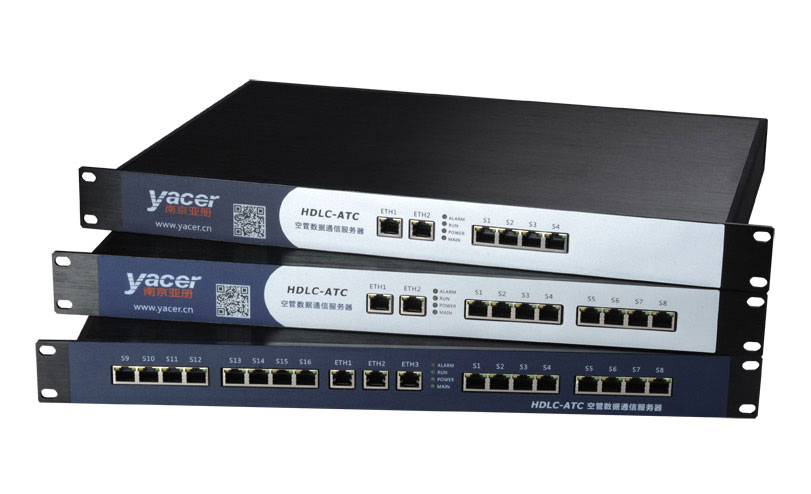
● Protocol conversion from the serial ports to Ethernet
● Protocol conversion from the Ethernet to serial ports
● Multiplexer of serial ports, support the serial port to be divided into multiple channels
● Air traffic control and the monitoring system, ADS-B, secondary radar (SSR) signal connection and output
● Air Traffic Control (ATC), Air Traffic Management (ATM)
● Data recording and playback of ATC Radar
● Frame application
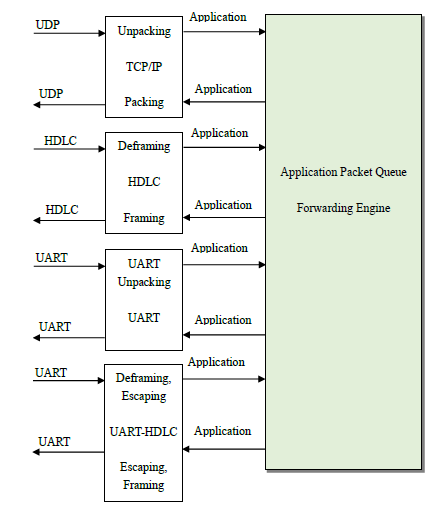
3.1 Appearance
The chassis adopts the 19-inch standard chassis with the 1U height.
The front panel includes 2, 4, 8 or 16-channel serial interfaces (S1~S16), 2 or 3 Ethernet interface (ETH1 ~ ETH3) with the RJ-45 connector adopted for the serial port and Ethernet interface.
The rear panel includes:
● Power switch
● AC power socket: 110V/220V AC power input, with a fuse
● DC power socket: 9~36VDC input, with an on-board self-healing fuse
● Ground stud
3.2 Ethernet Interface
Dual 10/100M Ethernet are adopted RJ-45 interface, support for auto MDI/MDI-X crossover, Ethernet switching and dual IP functions.
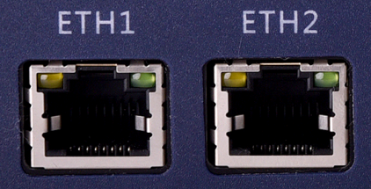
3.3 Serial Port
HDLC-ATC provides 2, 4, 8 or 16-channel RS-232 synchronous & a synchronous serial ports, each port supports HDLC protocol, and adopts RJ-45 connector. Each RJ45 interface is equipped with two indicator lights, among which the yellow light flashes to indicate data transmission and the green light flashes to indicate data reception.
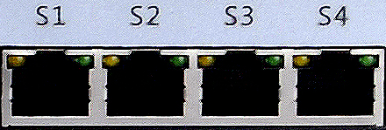
Serial ports S1, S2 are synchronous and asynchronous, with support for the synchronous and asynchronous working modes described in the table below.
|
Working Mode |
Description |
Serial ports |
|
|
Asynchronous |
UART |
Universal asynchronous serial, equivalent to the serial port on the common computer |
S1, S2 |
|
HDLC |
UART-based similar HDLC communication protocol |
S1, S2 |
|
|
Synchronous |
HDLC |
Synchronous HDLC protocol based on the synchronous HDLC protocol |
S1, S2 |
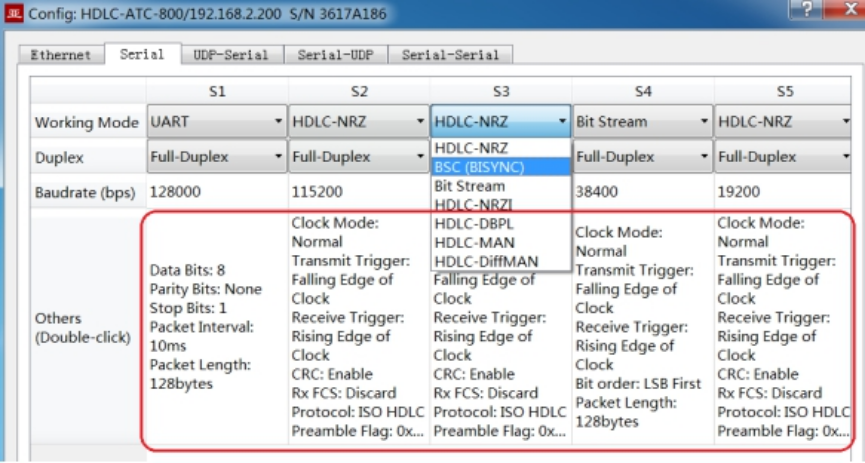
3.4 Power Supply
AC+DC redundancy, AC priority. AC supports the 110V/220V standard while DC adopts the 3-core XLR interface.
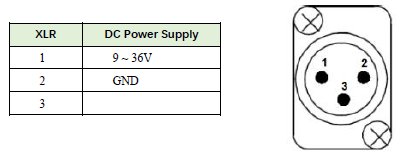
3.5 LED Indicators
LED indicators on the front panel are as follows:
|
LED |
Color |
Description |
|
ALARM |
Red |
Alarm indicator, flashing during initialization Light on during operation indicates the device failure |
|
RUN |
Green |
Running indicator, flashing during normal operation |
|
POWER |
Green |
Power indicator, constantly on after powered |
|
MAIN |
Green |
Light on indicates that the main power supply is applied Light off indicates that the standby power supply is applied |

With HDLC-ATC, PC or server can realize the transmit function of the synchronous HDLC serial port.
The typical application is shown as follows. PC sends a UDP message over the Ethernet interface as the UDP Client, and HDLC-ATC sends it out from the synchronous serial port after converting the received UDP message into the HDLC frame or the UART data.
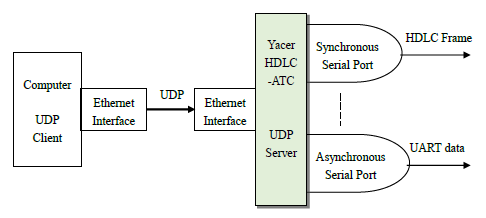
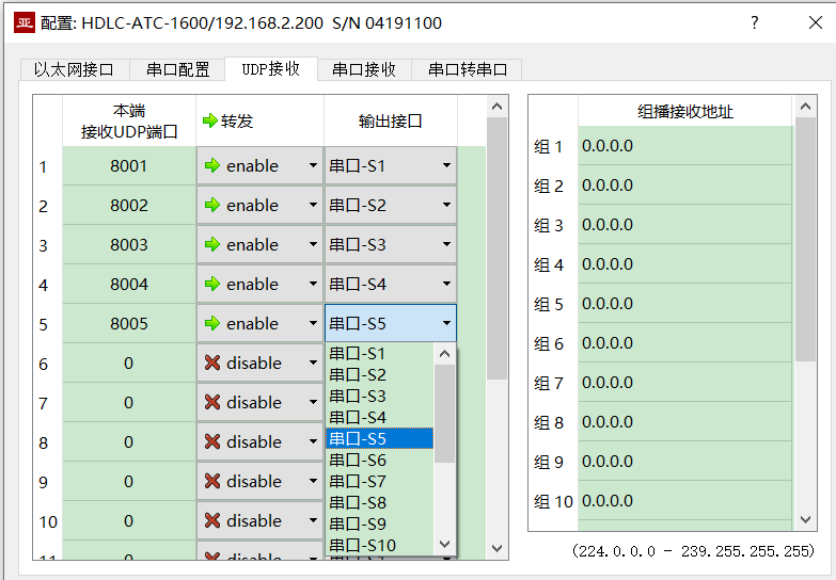
4.2 Serial to UDP Conversion
The HDLC-to-UDP function figures is shown below. HDLC-ATC receives the synchronous HDLC frame or asynchronous UART frame from other devices over the serial interface, converts it into the UDP message and sends to PC or server over Ethernet.
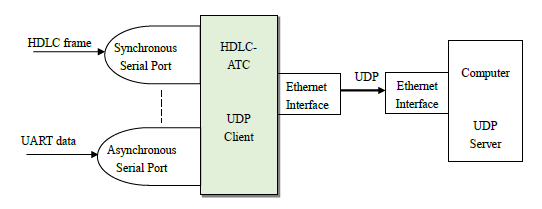
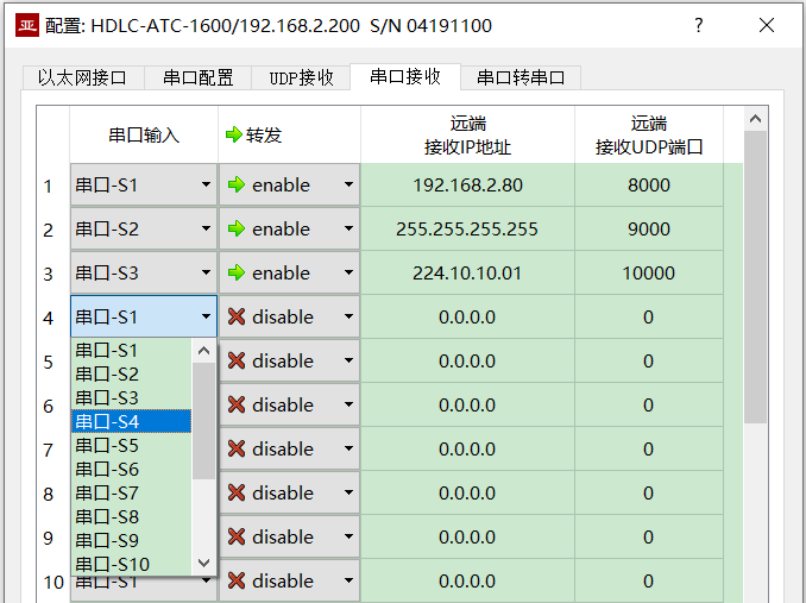
4.3 Serial Port to Serial Port
Serial-serial can forward the input data of the specified serial port to other serial port outputs, which is mainly used for:
● Conversion between synchronous and asynchronous serial ports
● Serial port Demultiplexer: Divide the single serial port data into multi-channel data. Unlike the common demultiplexer, demultiplexing is possible with HDLC-ATC, the different baud rates and clock modes can be set for each-channel serial port, avoiding the packet loss caused by clock inconsistency.
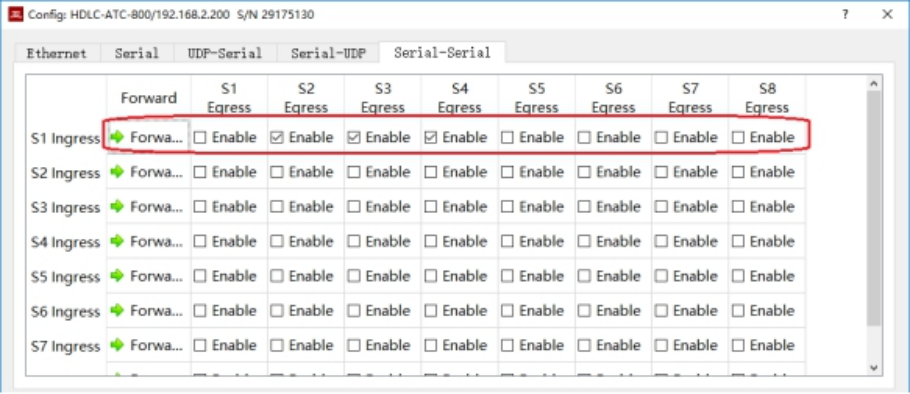
Configuration shown above realizes the application of the input demultiplexing of the serial port S1 to S2, S3 and S4 outputs. HDLC-ATC performs storing and forwarding on the received data. Even if the baud rate and clock mode of S1, S2, S3 and S4 are different, packet will not loss.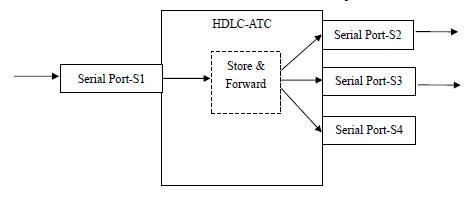
5. Secondary development
The cores of HDLC-ATC-800 and HDLC-ATC-1600 contain two independent CPUs, which interact data through shared memory:
● Communication CPU: provide network and serial port communication support and configuration management support;
● Application CPU: run the business software by the user for secondary development, and process the data from the communication CPU.
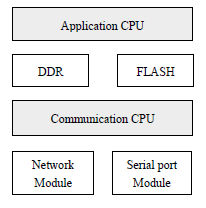
The system data flow is as follows:
● Receiving process of UDP: TCP / IP protocol stack of communication CPU receives UDP message, which is converted into UDP data and sent to application CPU through shared memory;
● Transmission process of UDP: the application CPU sends the UDP message to the communication CPU through the shared memory, and the TCP / IP protocol stack of the communication CPU processes it and converts it into UDP message sent through the Ethernet module;
● Receiving process of Serial port: the communication CPU receives data through the serial port module, and delivers it to the application CPU for reading and processing through the shared memory;
● Transmission process of Serial port: the application CPU sends the serial port data to be sent to the communication CPU through the shared memory, and then sends it through the serial port module framing.
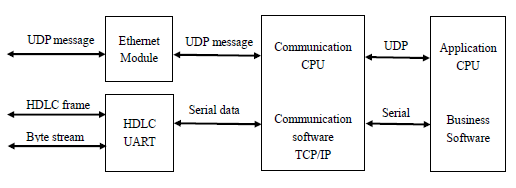
|
Serial Port |
|
|
Quantity |
2, 4, 8, 16 x RJ-45 |
|
Working mode |
Synchronous HDLC, Asynchronous UART |
|
Interface type |
RS-232 full-duplex |
|
Encoding format |
NRZ |
|
Baud rate |
≤250 Kbps |
|
Synchronous clock |
Normal, slave and master clock mode |
|
ESD protection |
± 15 KV |
|
Ethernet Interface |
|
|
Quantity |
2、3 x RJ-45 |
|
Function |
Support Ethernet switching and dual IP functions |
|
Rate |
10/100 Mbps, Auto MDI/MDI-X |
|
Network protocol |
TCP/IP |
|
Programming interface |
UDP Server, UDP Client Unicast/Multicast/Broadcast |
|
Secondary development support(Only for HDLC-ATC-800、HDLC-ATC-1600) |
|
|
CPU |
Arm cortex-a9 processor, main frequency 500 MHz |
|
Memory |
DDR3, 128MB |
|
FLASH |
Version space 6MB, Configuration space 1MB |
|
Interface |
Data interaction based on shared memory with CPU |
|
Configuration Management |
|
|
Configuration tool |
yacer-DMS configuration management software |
|
Configuration interface |
Ethernet interface |
|
Power Requirements |
|
| Power redundancy | Dual AC redundancy (AC2 priority) AC + DC redundancy (AC priority) |
|
AC power supply |
85 ~ 265 VAC |
|
DC power supply |
9 ~ 36 VDC |
|
Power consumption |
< 10 W |
|
Mechanical Characteristics |
|
|
Dimensions |
1U, 19-inch standard rack-mounted chassis fanless design |
|
Weight |
3 kg |
|
Operating Environment |
|
|
Operating temperature |
-10 ~ +60℃ |
|
Storage temperature |
-30 ~ +75℃ |
|
Operating humidity |
30 ~ 90% RH (non condensing) |
|
Storage humidity |
10 ~ 90% RH (non condensing) |
|
RJ45 Pin |
RS-232 |
Description |
|
1 |
GND |
Ground |
|
2 |
TxData |
Transmit Data |
|
3 |
|
|
|
4 |
TxClock |
Transmit Clock |
|
5 |
|
|
|
6 |
RxData |
Receive Data |
|
7 |
|
|
|
8 |
RxClock |
Receive Clock |
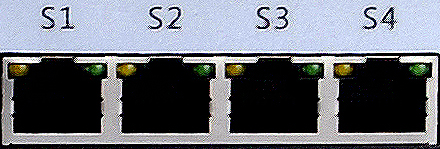
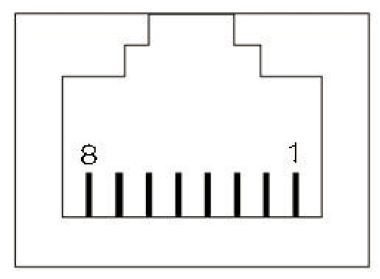
|
Product Model |
Serial Port |
Ethernet Interface |
Power Redundancy |
|
HDLC-ATC-400-AA |
4 x RS-232 synchronous serial port, two of which support asynchronous |
2 x 10/100M |
Dual AC |
|
HDLC-ATC-800-AA |
8 x RS-232 synchronous serial port, two of which support asynchronous |
2 x 10/100M |
Dual AC |
|
HDLC-ATC-1600-AA |
16 x RS-232 synchronous serial port, two of which support asynchronous |
3 x 10/100M |
Dual AC |
|
HDLC-ATC-400 |
4 x RS-232 synchronous serial port, two of which support asynchronous |
2 x 10/100M |
AC+DC |
|
HDLC-ATC-800 |
8 x RS-232 synchronous serial port, two of which support asynchronous |
2 x 10/100M |
AC+DC |
|
HDLC-ATC-1600 |
16 x RS-232 synchronous serial port, two of which support asynchronous |
3 x 10/100M |
AC+DC |
| Icon |
Function |
Tools and software |
  |
||
  |
||
  |
 Products
Products Application
Application Software
Software Technical & Services
Technical & Services About Us
About Us